- 已解决java.sql.SQLIntegrityConstraintV
- HashMap源码解读(中篇)
- mysql如何自定义自增主键值,以及所遇到的不生效问题
- IDEA搭建spring boot时报错Error: Request
- NL2SQL 自然语言生成SQL方案汇总
- Spring Boot集成knife4j
- Idea 反编译jar包
- 查看mysql 或SQL server 的连接数,mysql超时、最大
- 无人新零售引领的创新浪潮
- 基于时域有限差分法的FDTD的计算电磁学算法-YEE网格下的更新公式推
- (保姆级)使用idea省心又省力地配置sbt,编译Scala代码
- Spring Boot:基础配置
- -bash: hadoop: 未找到命令
- 高级DBA手把手教你Mysql大数据量批量导入人大金仓国产数据库方法(
- Rust|60个新手常犯的错误
- Spring Cloud LoadBalancer 负载均衡策略与缓存
- 【spring】 ApplicationListener的使用及原理简
- MySQL— 基础语法大全及操作演示!!!(上)
- Springboot利用CompletableFuture异步执行线程
- Modbus报文详解
- 如何下载IDEA2023.3.4 最新激活破解教程
- 华为ensp中MSTP多网段传输协议(原理及配置命令)
- plsql developer 一键格式化sql美化sql
- 推荐系统算法 协同过滤算法详解(三)Springboot 实现基于用户
- 如何使用phpStudy快速搭建一个网站
- 21、Lua 面向对象
- 基于YOLOv的目标追踪与无人机前端查看系统开发
- 自动化机器学习流水线:基于Spring Boot与AI机器学习技术的融
- Spring Boot:Web应用开发之增删改查的实现
- SpringBoot整合Minio的详细步骤
目录
- 第一章、使用@Value注解
- 第二章、使用@PropertySource注解
- 2.1)指定文件路径,在setter方法上添加@Value注解
- 2.2)指定文件路径,在属性上添加@Value注解
- 2.3)使用ApplicationContextAware接口来获得TConfig中对应properties文件的属性值
- 2.3.1)TaskConfig类与TestTaskConfig类
- 2.3.2)ConfigLoder类
- 2.3.3)启动类:启动只运行一次
- 2.3.4)springUtil类实现ApplicationContextAware接口
- 2.3.5)TestGetProperties测试类:测试获取属性值
- 第三章、使用@Configurationproperties注解
- 第四章、使用Java Properties类
- 第五章、使用Environment接口
- 第六章、使用ResourceBundle类
友情提醒:
先看文章目录,大致了解文章知识点结构,点击文章目录可直接跳转到文章指定位置。有用记得关注
第一章、使用@Value注解
①@Value注解用于获取配置文件中的属性定义并绑定到Java Bean或属性中。在核心配置文件applicatin.properties中,添加两个自定义配置项school.name和school.website。
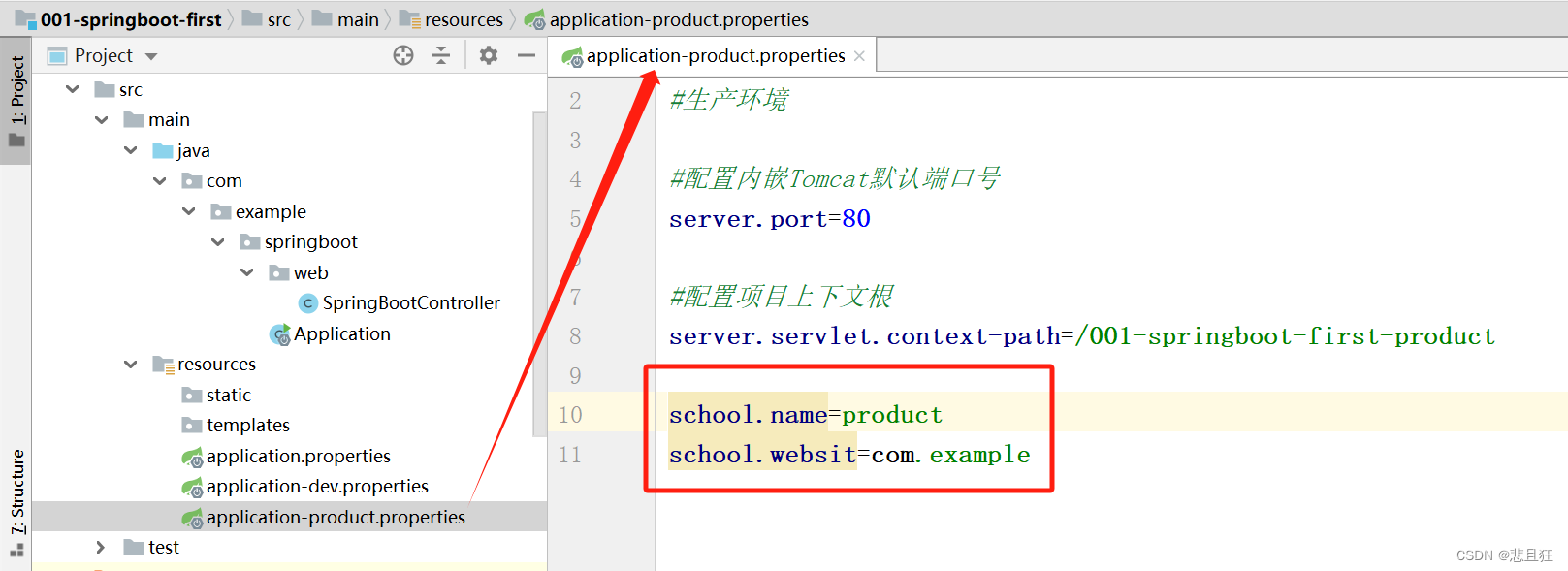
②在SpringBootController中定义属性,并使用@Value注解或者自定义配置值,并对其方法进行测试
package com.example.springboot.web; import org.springframework.beans.factory.annotation.Value; import org.springframework.stereotype.Controller; import org.springframework.web.bind.annotation.RequestMapping; import org.springframework.web.bind.annotation.ResponseBody; @Controller public class SpringBootController { @Value("${school.name}") private String schoolName; @Value("${school.websit}") private String schoolWebsit; @RequestMapping(value = "/springBoot/first") @ResponseBody public String say() { return schoolName + "------" + schoolWebsit; } }③访问浏览器成功,说明成功通过@value读取配置的属性值

第二章、使用@PropertySource注解
2.1)指定文件路径,在setter方法上添加@Value注解
@PropertySource(“classpath:coremail.properties”)是指定配置文件位置的注解。Spring 可以在类路径下找到并加载这个coremail.properties属性文件。需要再在属性上面搭配@value注解使用其中定义的属性值。
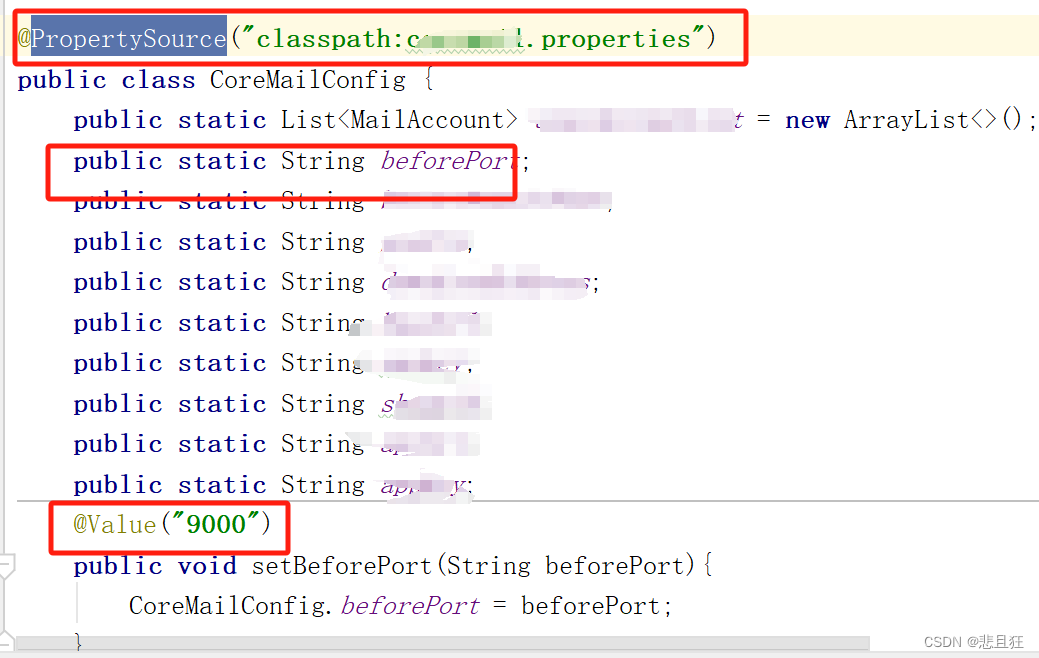
2.2)指定文件路径,在属性上添加@Value注解

2.3)使用ApplicationContextAware接口来获得TConfig中对应properties文件的属性值
2.3.1)TaskConfig类与TestTaskConfig类
有两个配置文件,使用两个config类指定properties类文件路径

@Configuration//当一个类被标注了@Configuration注解时,Spring会将这个类识别为配置类, // 用于定义Bean的创建和配置。即使没有显式地定义Bean,配置类本身也可以被注入到其他类中 @PropertySource(value = {"classpath:mailSendConfig.properties"},encoding="utf-8") public class TaskConfig { }@Configuration @PropertySource(value = {"classpath:testConfig.properties"},encoding="utf-8") public class TestTaskConfig { }
2.3.2)ConfigLoder类
用来加载config类
@Component public class ConfigLoder { @Autowired static TaskConfig taskConfig; @Autowired static TestTaskConfig testTaskConfig; public static TaskConfig getTaskConfig(){ return taskConfig; } public static TestTaskConfig getTestTaskConfig(){ return testTaskConfig; } }
2.3.3)启动类:启动只运行一次
//@SpringBootApplication public class LineApplication implements ApplicationRunner { @Override public void run(ApplicationArguments args) throws Exception{ System.out.println("===================="); XXXXService mailSend =new XXXXService(); mailSend.run(); } public static void main(String[] args){ SpringApplication.run(LineApplication.class,args); } }2.3.4)springUtil类实现ApplicationContextAware接口
通过实现ApplicationContextAware接口获取ApplicationContext对象,来获得TaskConfig中对应properties文件的属性值。
@Component public class SpringUtil implements ApplicationContextAware { private static ApplicationContext applicationContext = null; @Override public void setApplicationContext(ApplicationContext applicationContext) throws BeansException { if (SpringUtil.applicationContext == null) { SpringUtil.applicationContext = applicationContext; } } public static ApplicationContext getApplicationContext() { return applicationContext; } public static Object getBean(String name) { return getApplicationContext().getBean(name); } public staticT getBean(Class clazz) { return getApplicationContext().getBean(clazz); } public static T getBean(String name, Class clazz) { return getApplicationContext().getBean(name, clazz); } public static String getProperty(String propertyName) { return getApplicationContext().getEnvironment().getProperty(propertyName); } public static String getProperty(Class clazz, String PropertyName) { AnnotationConfigApplicationContext context = new AnnotationConfigApplicationContext(clazz); ConfigurableEnvironment configurableEnvironment = context.getEnvironment(); return configurableEnvironment.getProperty(PropertyName); } } 2.3.5)TestGetProperties测试类:测试获取属性值
package com.icbc.app.runner; import com.icbc.app.config.SpringUtil; import com.icbc.app.config.TaskConfig; import com.icbc.app.config.TestTaskConfig; import org.springframework.stereotype.Component; import java.util.ResourceBundle; @Component public class TestGetProperties { public void run(String... args) throws Exception { //第一种:获取系统环境的 systemTime 值 System.out.println("系统值systemTime=" + System.getenv("CALLTIME")); //第二种:ResourceBundle获取testConfig配置文件的的 name 值 ResourceBundle bundle = ResourceBundle.getBundle("testConfig"); String name = bundle.getString("name"); System.out.println("ResourceBundle获取name值=" + name); //第三种:TaskConfig.properties的sleepTime值 String sleepTime = SpringUtil.getProperty(TaskConfig.class, "sleepTime"); System.out.println("TaskConfig.properties的sleepTime值="+sleepTime); //第四种:TestTaskConfig.properties文件的Time值 String time = SpringUtil.getProperty(TestTaskConfig.class, "Time"); System.out.println("TestTaskConfig.properties文件的Time值="+time); } }第三章、使用@Configurationproperties注解
@Configurationproperties(prefix=”xxx”)prefix的作用是区分同名配置,如果不指定,那么会去配置文件中寻找与该类的属性名一致的配置文件。
prefix怎么使用呢?
在生产环境配置文件applicatin-product.properties中,有自定义的三个school前缀的配置项
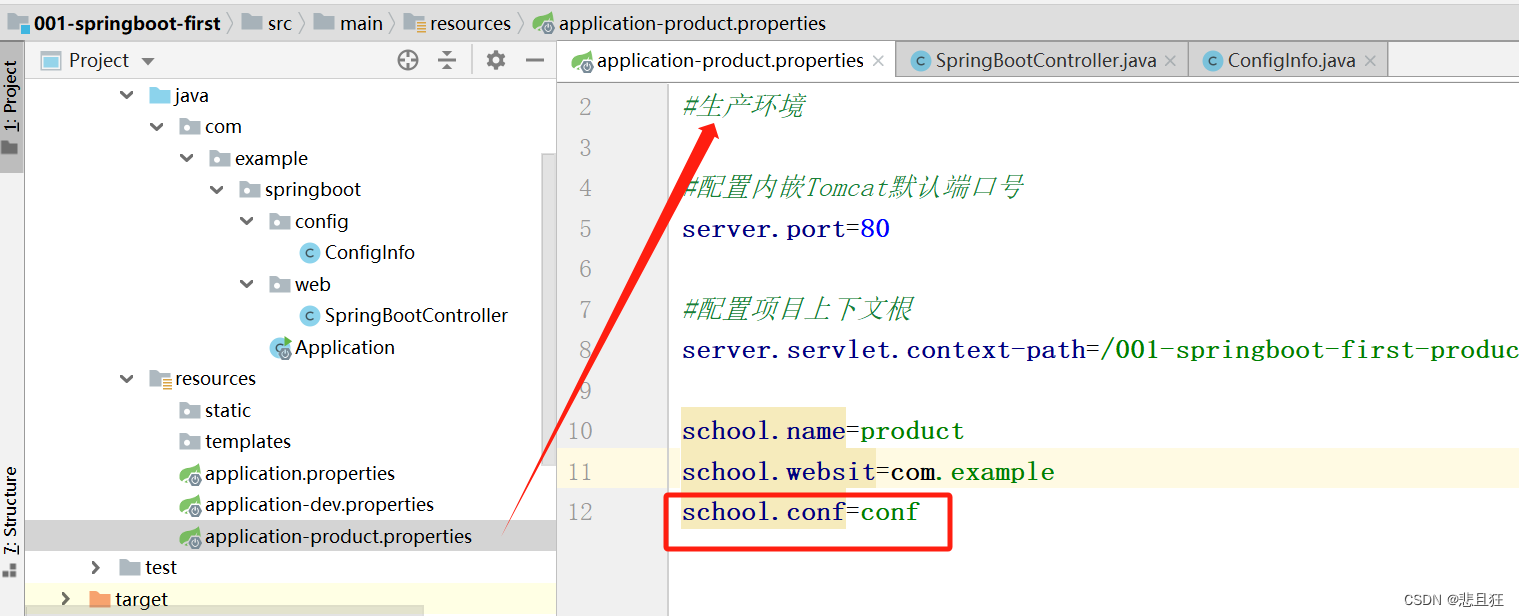
在核心配置文件applicatin.properties中激活生产环境,这里的product对应文件名application-produc的横杠后面的produc
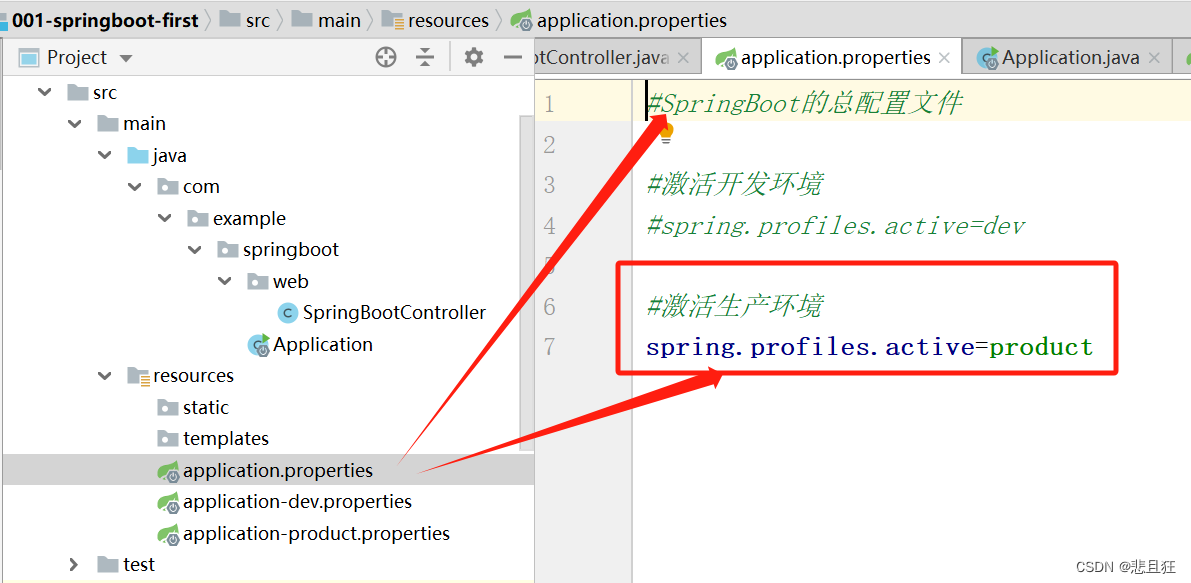
当指定prefix之后,就不需要再在属性上面搭配@value注解使用,因为当指定前缀school之后,属性就会自动注入
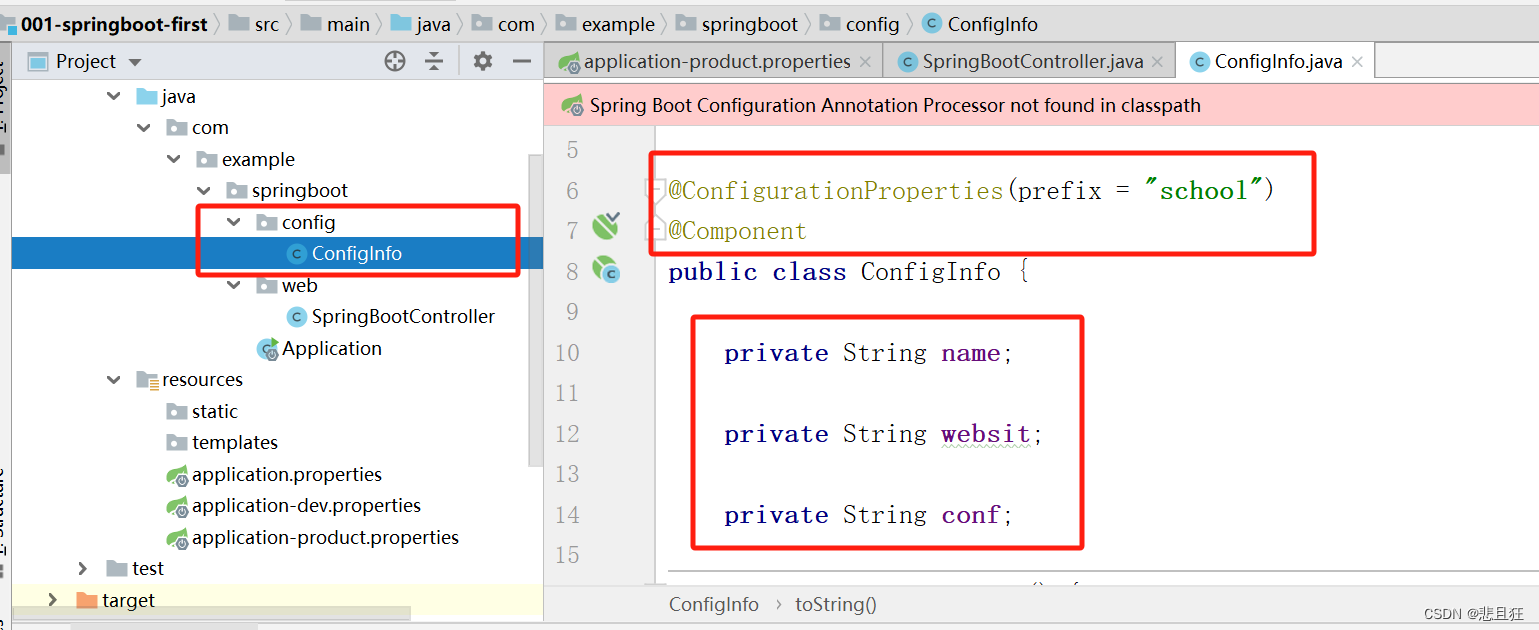
第四章、使用Java Properties类
Properties prop = new Properties(); try (InputStream input = new FileInputStream("config.properties")) { prop.load(input); String dbUrl = prop.getProperty("db.url"); String dbUser = prop.getProperty("db.user"); String dbPassword = prop.getProperty("db.password"); // 使用读取到的属性进行后续操作 } catch (IOException ex) { ex.printStackTrace(); }第五章、使用Environment接口
配置文件如图:
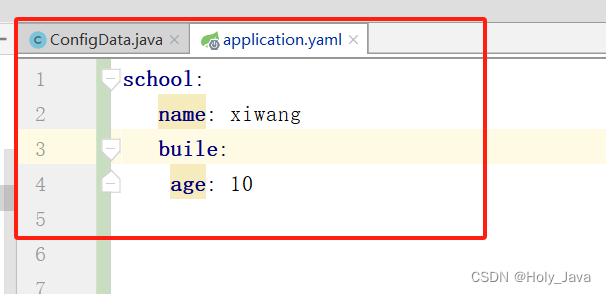
获取配置文件中的属性值:
import org.springframework.beans.factory.annotation.Autowired; import org.springframework.core.env.Environment; import org.springframework.stereotype.Component; @Component public class MyComponent { public static String Value1 ; public static String Value2 ; @Autowired private Environment environment; public void getPropertyFromEnvironment() { Value1 = environment.getProperty("school.name"); Value2 = environment.getProperty("school.buile.age"); System.out.println("Value1: " + Value + "Value1: "+Value2 ); } }第六章、使用ResourceBundle类
新建一个配置文件:ResourceBunTest.properties,信息如下图
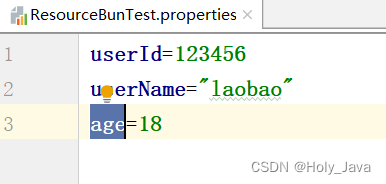
使用ResourceBundle类获取配置文件内容
public class ResourceBundleTest { public static void main(String[] args) { testResoBund(); } //获取配置文件信息的方法 public static void testResoBund(){ //根据配置文件名称获得ResourceBundle 对象 ResourceBundle bundle = ResourceBundle.getBundle("ResourceBunTest"); String userId = bundle.getString("userId"); String userName = bundle.getString("userName"); String age = bundle.getString("age"); System.out.println(userId+"---"+userName+"---"+age); } }测试结果:获取成功

上一篇:一文深入搞懂ARM处理器架构














